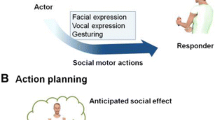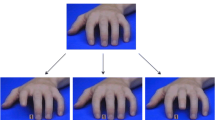Abstract
It has been suggested that the deficit in understanding others’ intention in autism depends on a malfunctioning of the mirror system. This malfunction could be due either to a deficit of the basic mirror mechanism or to a disorganization of chained action organization on which the mirror understanding of others’ intention is based. Here we tested this last hypothesis investigating the kinematics of intentional actions. Children with autism and typically developing children (TD) were asked to execute two actions consisting each of three motor acts: the first was identical in both actions while the last varied for its difficulty. The result showed that, unlike in TD children, in children with autism the kinematics of the first motor act was not modulated by the task difficulty. This finding strongly supports the notion that children with autism have a deficit in chaining motor acts into a global action.


Similar content being viewed by others
References
Altschuler EL, Vankov A, Wang V, Ramachandran VS, Pineda JA (1997) Person see, person, poster session. Presented at the 27th annual meeting of the society for neuroscience, New Orleans, November 1997
Boria S, Fabbri-Destro M, Cattaneo L, Sparaci L, Sinigaglia C, Santelli E, Cossu G, Rizzolatti G (2008) ‘What’ and ‘why’ in autism (submitted)
Cattaneo L, Fabbri-Destro M, Boria S, Pieraccini C, Monti A, Cossu G, Rizzolatti G (2007) Impairment of actions chains in autism and its possible role in intention understanding. Proc Natl Acad Sci USA 104:17825–17830
Cochin S, Barthelemy C, Roux S, Martineau J (1999) Observation and execution of movement: similarities demonstrated by quantified electroencephalography. Eur J Neurosci 11:1839–1842
Dapretto M, Davies MS, Pfeifer JH, Scott AA, Sigman M, Bookheimer SY, Iacoboni M (2006) Understanding emotions in others: mirror neuron dysfunction in children with autism spectrum disorders. Nat Neurosci 9:28–30
Fogassi L, Ferrari PF, Gesierich B, Rozzi S, Chersi F, Rizzolatti G (2005) Parietal lobe: from action organization to intention understanding. Science 308:662–667
Fuster JM (2002) Cortex and mind: unifying cognition. Oxford University Press, New York
Hadjikhani N, Joseph RM, Snyder J, Tager-Flusberg H (2006) Anatomical differences in the mirror neuron system and social cognition network in autism. Cereb Cortex 16:1276–1282
Hamilton AF, Brindley RM, Frith U (2007) Imitation and action understanding in autistic spectrum disorders: how valid is the hypothesis of a deficit in the mirror neuron system? Neuropsychologia 45:1859–1868
Hari R, Forss N, Avikainen S, Kirveskari E, Salenius S, Rizzolatti G (1998) Activation of human primary motor cortex during action observation: a neuromagnetic study. Proc Natl Acad Sci USA 95:15061–15065
Johnson-Frey SH, McCarty M, Keen R (2004) Reaching beyond spatial perception: effects of intended future actions on visually-guided prehension. Visual Cogn 11:371–399
Kanner L (1943) Autistic disturbances of affective contact. Nerv Child 2:217–250
Lord C, Rutter M, Di Lovore PC, Risi S (2005) Autism diagnostic observation schedule. Organizzazioni Speciali, Florence
Marteniuk RG, MacKenzie CL, Jeannerod M, Athenes S, Dugas C (1987) Constraints on human arm movement trajectories. Can J Psychol 41:365–378
Martineau J, Cochin S, Magne R, Barthelemy C (2008) Impaired cortical activation in autistic children: is the mirror neuron system involved? Int J Psychophysiol 68:35–40
Nishitani N, Avikainen S, Hari R (2004) Abnormal imitation-related cortical activation sequences in Asperger’s syndrome. Ann Neurol 55:558–562
Oberman LM, Hubbard EM, McCleery JP, Altschuler EL, Ramachandran VS, Pineta JA (2005) EEG evidence for mirror neuron dysfunction in autism spectrum disorders. Brain Res Cogn Brain Res 24:190–198
Oberman LM, Ramachandran VS, Pineda JA (2008) Modulation of mu suppression in children with autism spectrum disorders in response to familiar or unfamiliar stimuli: the mirror neuron hypothesis. Neuropsychologia 46:1558–1565
Raven JC (1984) Coloured progressive matrices. Organizzazioni Speciali, Florence
Rubini V, Padovani F (1986) Wechsler intelligence scale for children revised. Organizzazioni Speciali, Florence
Tanji J, Hoshi E (2008) Role of the prefrontal cortex n executive behavior control. Physiol Rev 88:37–57
Théoret H, Halligan E, Kobayashi M, Fregni F, Tager-Flusberg H, Pascual-Leone A (2005) Impaired motor facilitation during action observation in individuals with autism spectrum disorder. Curr Biol 15:R84–R85
Williams JH, Whiten A, Suddendorf T, Perrett DI (2001) Imitation, mirror neurons and autism. Neurosci Biobehav Rev 25:287–295
Acknowledgments
The research described here is outside the main interests of Giovanni Berlucchi. However, all the authors of the present study, and GR in particular, are pleased to dedicate it to him for how much he contributed to their intellectual and scientific formation. The study was supported by EU Contract 012738, Neurocom, by PRIN 2006 to GR, and by Fondazione Monte Parma (FMP). M.F-D. was supported by Fondazione Cassa di Risparmio di Ferrara. We thank C. Pieraccini, A. Monti, E. Santelli and F. Dalla Vecchia for their clinical contribution. We also thank L. Sparaci and R. Pitino for their help in some parts of the experiment.
Author information
Authors and Affiliations
Corresponding author
Rights and permissions
About this article
Cite this article
Fabbri-Destro, M., Cattaneo, L., Boria, S. et al. Planning actions in autism. Exp Brain Res 192, 521–525 (2009). https://doi.org/10.1007/s00221-008-1578-3
Received:
Accepted:
Published:
Issue Date:
DOI: https://doi.org/10.1007/s00221-008-1578-3




